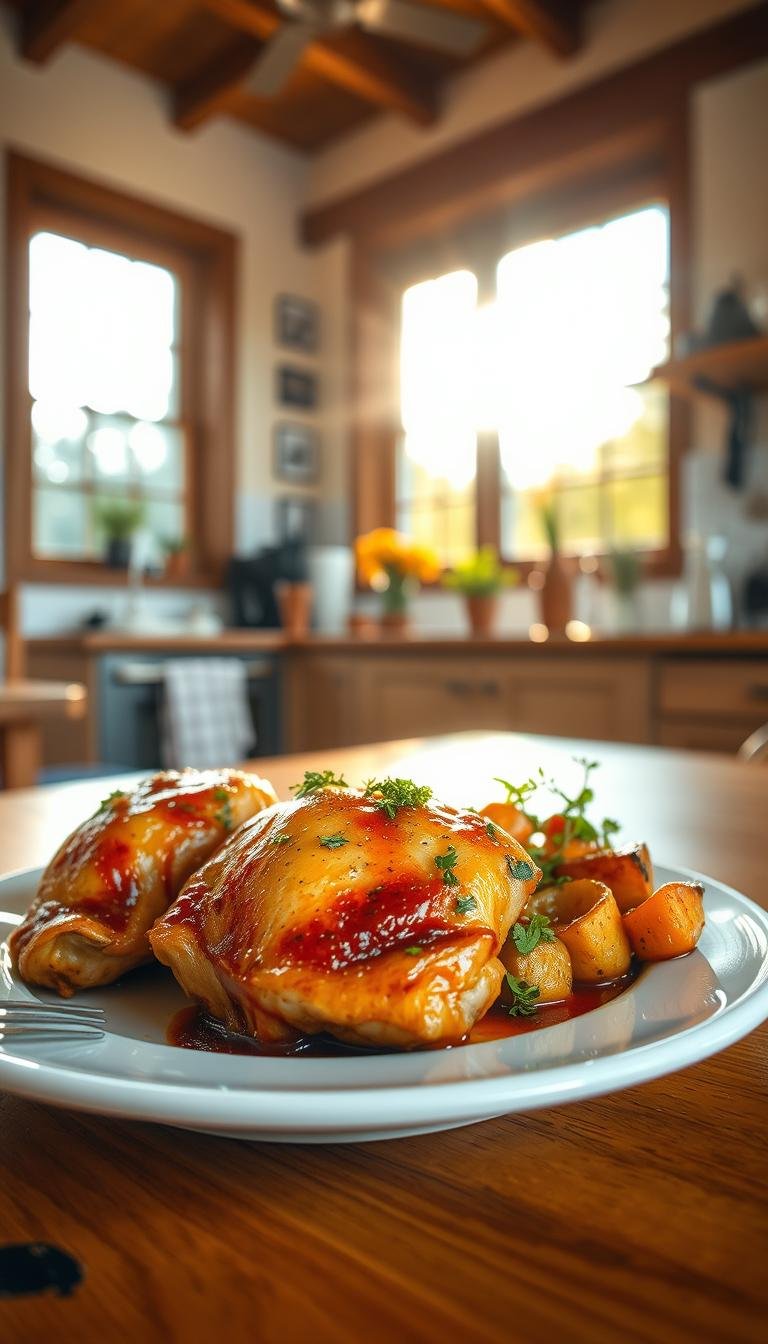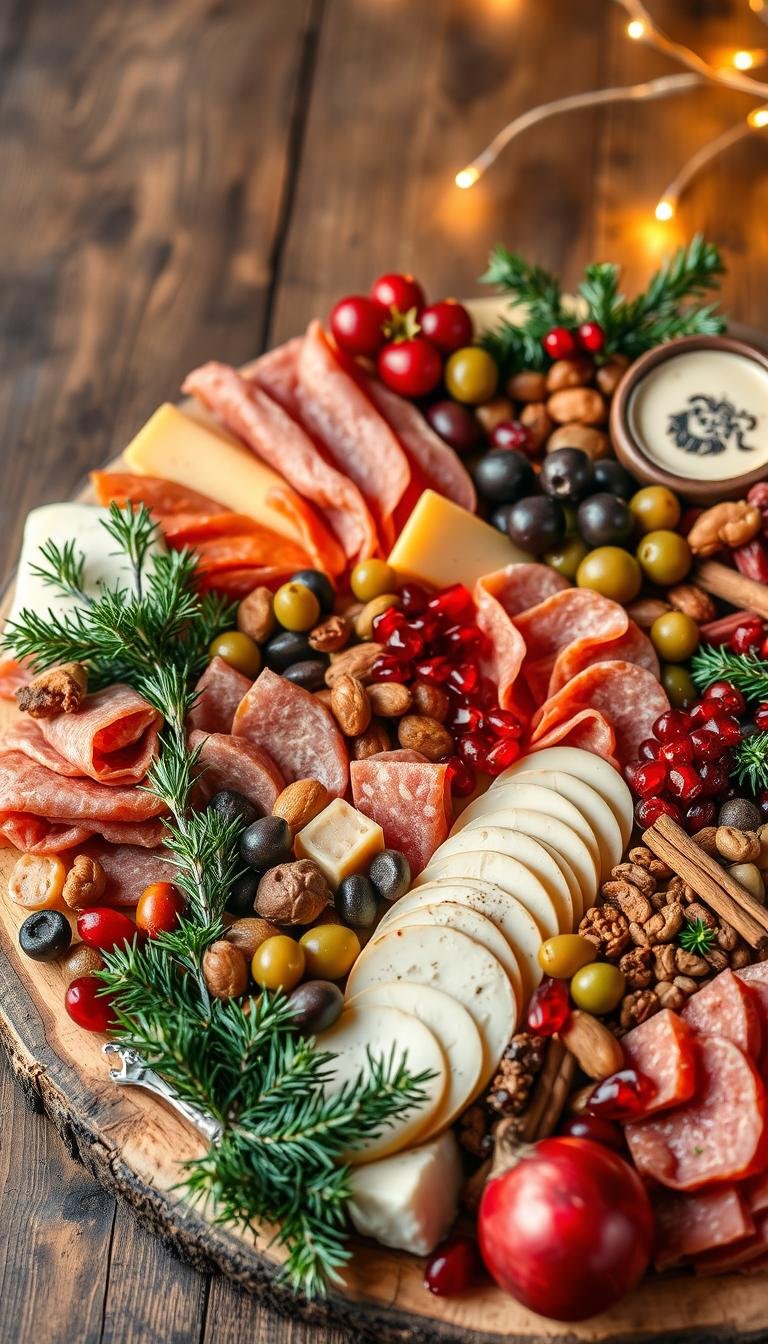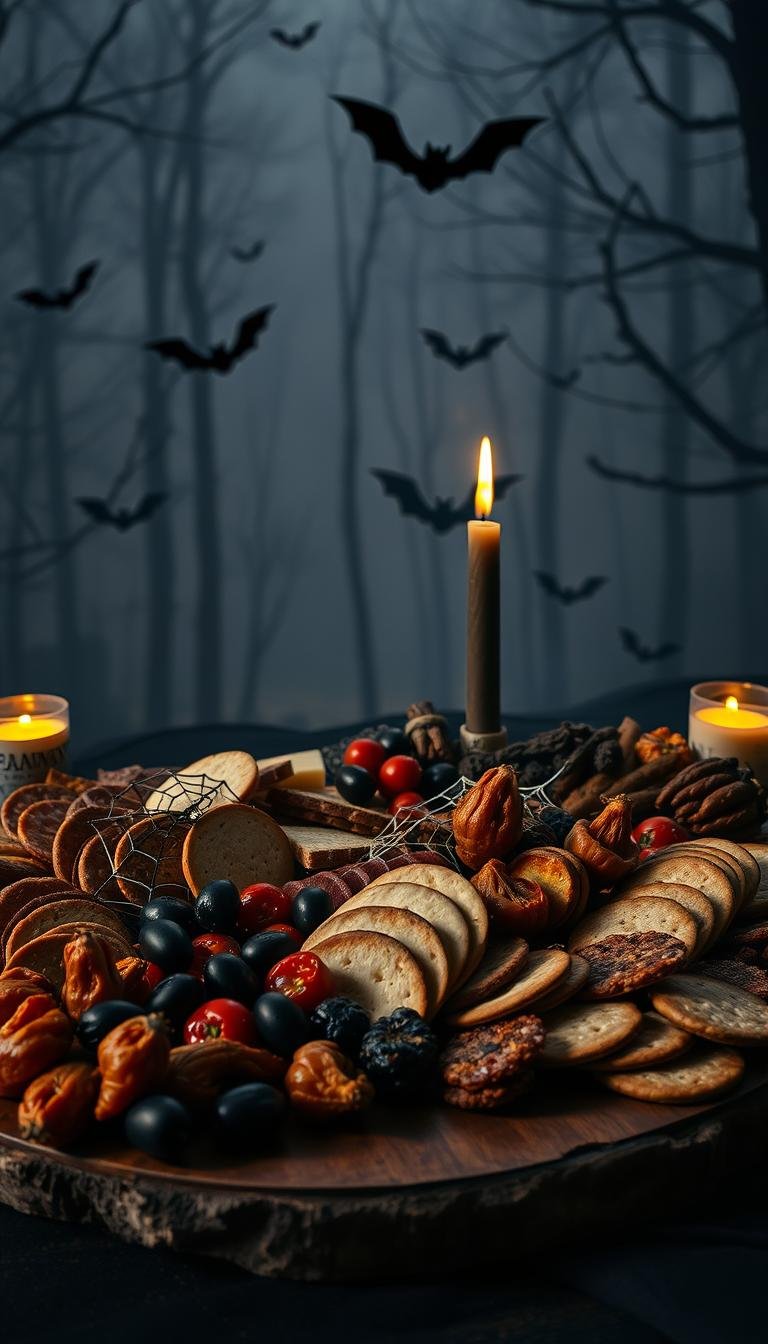Easy Chicken Thigh Recipes: Simple Dinners in Minutes
Surprising fact: U.S. households serve thighs more often now because they cost less and deliver more flavor per bite than many other cuts.
Weeknight wins start with a cut that stays juicy and forgives minor timing mistakes. These methods—skillet sears finished with a garlic cream sauce, quick 400°F oven bakes, and one-pan sheet‑pan meals—get dinner on the table in minutes while keeping skin crisp and meat tender.
Season simply with salt, black pepper, paprika, garlic powder, and onion powder to build reliable flavor. Aim for a safe internal temp of 165°F; many cooks take thighs to 180–190°F for ultra-tender results, then rest briefly before serving.
What this guide covers: three core methods, staple seasoning blends, quick sides like a green salad or roasted potatoes, and reheating tips that preserve crisp skin using the oven or air fryer. Nutrition varies by approach—about 360 kcal for a skillet cream sauce serving and roughly 575 kcal for a loaded sheet pan—so you can pick the meal that fits your needs.
Key Takeaways
- Thighs are budget-friendly and stay juicy, making them ideal for weeknight meals.
- Three reliable methods: skillet with pan sauce, 400°F oven bake, and sheet pan roast.
- Use a simple rub of salt, pepper, paprika, garlic, and onion powder to boost flavor.
- Safe doneness is 165°F; higher temps yield more tender meat—rest before serving.
- Reheat in the oven or air fryer to keep skin crisp; microwave will soften it.
- Calories vary by method—choose lighter sides to lower overall meal kcal.
Quick, flavorful dinners with chicken thighs made easy
A cast-iron sear, a steady oven, or a single sheet pan converts a few pantry spices into a weeknight winner in under an hour. These three approaches give reliable flavor with very little fuss.
How to pick a way: use a hot skillet for a fast sauce-forward meal, roast at 400°F for a set-and-forget oven dinner, or load a pan with veggies and bake 50–55 minutes for a one-tray supper.
Keep heat moderate on the stove to avoid burning. For the oven, steady 400°F yields consistent browning; finish with a quick broil if you want extra crisp skin.
“An instant-read thermometer removes guesswork. Aim for 165°F for safety or 180–190°F for extra-tender results.”
| Method | Time | Best for | Notes |
|---|---|---|---|
| Skillet to oven | 15–30 minutes | Sauce, quick sides | Medium stovetop heat, finish in oven to temp |
| Oven bake | 30–40 minutes | Hands-off weeknight | 400°F; broil briefly for crisp skin |
| Sheet pan | 50–55 minutes | One-tray dinners | Veggies catch drippings for added flavor |
Pat dry, rub with a simple seasoning, add oil, and go—no marinating required. Rest the meat a few minutes after cooking so juices redistribute.
Pairings: quick salads suit skillet meals; roasted potatoes and root vegetables match sheet pan or oven approaches. These methods are forgiving, repeatable, and built for busy nights.
Staple ingredients for easy chicken thigh recipes
Start with a small list of reliable pantry ingredients to make consistently flavorful meals. A focused box of spices, a quality oil, and one finishing fat will cover sears, oven bakes, and sheet-pan dinners.
Essential seasoning
Dependable base rub: kosher salt, black pepper, 1/2 teaspoon each garlic powder, onion powder, and paprika per portion, plus a sprinkle of Italian seasoning for herbs. This mix adds color and savory depth with minimal fuss.
Oils and fats
Use olive oil to help the rub adhere and to promote browning at moderate heat. Reserve butter for pan sauces and finishing so it enriches the sauce without burning.
Bone-in, skin-on vs boneless cuts
Bone-in, skin-on thighs deliver the best flavor and crisp skin but need more minutes and slightly lower oven heat to finish safely. Boneless chicken cooks faster and is ideal when time is tight or you plan to slice for a bowl.
- Measure roughly a teaspoon total seasoning per thigh and adjust salt or paprika to taste.
- Pat pieces dry and toss in a bowl with oil to coat evenly before seasoning.
- For creamy finishes, use heavy cream or swap half-and-half; coconut milk works for dairy-light options.
Skillet chicken thighs with garlic cream sauce
A quick sear in a heavy pan creates the base for a silky garlic cream sauce and tender meat. Pat the pieces dry and rub with garlic powder, onion powder, paprika, salt, and black pepper. This step helps the skin crisp and keeps the meat juicy.
Step-by-step sear and finish
Heat a cast-iron skillet to medium heat with a thin film of olive oil. Place chicken skin-side down and sear until the skin is deeply golden and crisp, about 7–8 minutes.
Flip and cook another 15–25 minutes, watching the thickest thigh until it reaches 165°F. Remove the pieces to a plate while you build the sauce.
Build the sauce
Lower the heat, melt butter, and sauté a minced shallot and two cloves of garlic for about 1 minute. Stir in 1/2 cup chicken broth, 1 tablespoon fresh lemon juice, thyme sprigs, and a pinch of red pepper flakes.
Slowly add heavy cream and simmer about 5 minutes until the sauce thickens and coats the spoon. Return the meat to the pan, spoon the sauce over, and garnish with chopped parsley.
Pro tips and storage
Keep skin elevated above pooling liquid to preserve crispness. Half-and-half or full-fat coconut milk can replace heavy cream if needed, though coconut will be slightly sweeter.
“An instant-read thermometer removes guesswork—aim for 165°F for safety.”
Store leftovers up to 4 days chilled or freeze for 3 months. Reheat gently in a 350°F oven for about 15 minutes or air fry 3–4 minutes to re-crisp skin before saucing.
Sheet pan chicken thighs with roasted root vegetables
A single sheet pan turns robust root vegetables and bone-in pieces into a hands-off, flavor-packed dinner. Preheat the oven to 400°F and line a sheet pan.
Toss chunky potatoes, onion, carrots, parsnips, rutabaga, and a few whole garlic cloves with about 2 tablespoons olive oil, salt, pepper, and roughly 2 teaspoons of a seasoning mix (Italian seasoning, granulated garlic, granulated onion, and paprika).
Spread the vegetables evenly. Season bone-in, skin-on chicken thighs with the remaining spice mix and a light drizzle of olive oil. Nestle the pieces on top so rendered fat bastes the vegetables as they roast.
Roast in the oven 50–55 minutes until the skin is deeply browned and crisp and the potatoes are fork-tender. Before serving, drizzle a bit more olive oil and scatter fresh thyme, rosemary, or parsley over the top.
Tips and quick variations
- Add Brussels sprouts or turnips, or add cherry tomatoes or butternut squash halfway through to prevent overcooking.
- Use an extra pan for larger batches to avoid crowding and steaming instead of roasting.
- Assemble ahead and refrigerate; bring to room temp 30–60 minutes before roasting for even cooking.
Oven-baked chicken thighs, fast and foolproof
Oven baking at a steady high heat gives reliably crisp skin and tender meat with minimal fuss. Trim excess skin and pat each piece dry, then place in a single layer in a 9×13-inch baking dish so heat circulates and the skin renders evenly.
Make a seasoning mix of salt, black pepper, onion powder, garlic powder, paprika, and Italian seasoning. Drizzle extra-virgin olive oil over the pieces and rub the mix in so it adheres.
400°F, 30–40 minutes: crisp skin, no flipping needed
Bake at 400°F for 30–40 minutes. There’s no need to flip; the hot air browns the top while fat renders below. Optionally broil for 1–3 minutes if you want shatter-crisp skin.
Internal temp: why 180–190°F gives ultra-tender results
Check the thickest piece with an instant-read thermometer. 165°F is safe, but many cooks take thighs to 180–190°F to break down connective tissue for extra tenderness. Let rest about 10 minutes before serving.
- Boneless chicken cooks about 10 minutes faster—begin checking earlier.
- For deeper browning, pre-sear in a skillet then finish in the oven and use drippings for a quick pan sauce.
“Resting keeps juices in the meat and yields a better texture slice to slice.”
How to season, sear, and bake for maximum flavor
Start by measuring spices precisely so every batch tastes the same each time. Mix paprika, garlic powder, onion powder, salt, and pepper in a small bowl using teaspoon measures. This gives a balanced base rub you can scale.
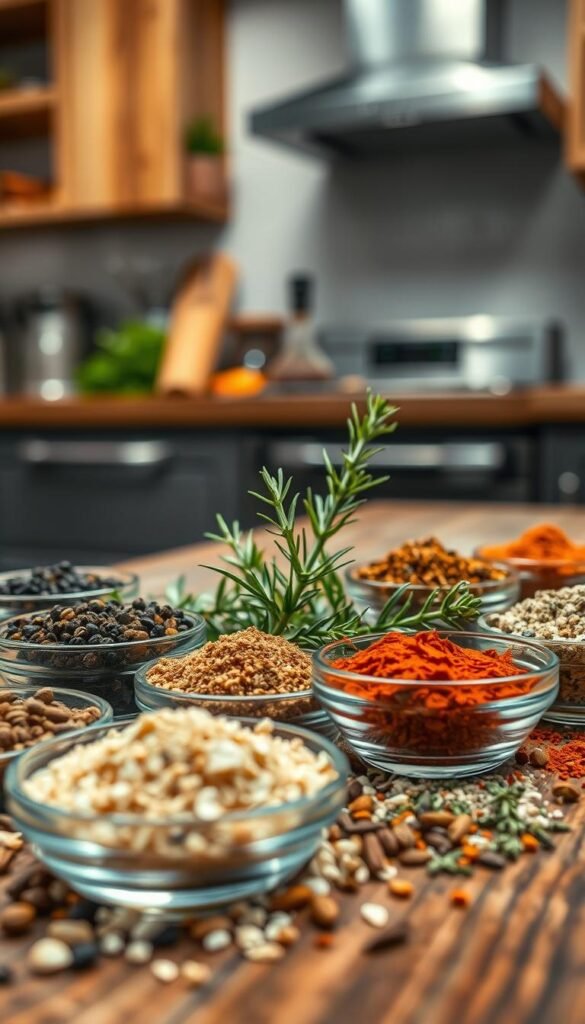
Pat the pieces dry and slick them with a little olive oil so the seasoning adheres. Preheat the pan and use medium heat to protect the spices while you render fat and build color.
Place chicken skin-side down first and leave it undisturbed until a golden crust forms. For thick pieces, finish in a hot oven; thin pieces can cook through on the stovetop with gentle heat control.
Quick checklist
- Build the rub in a bowl with teaspoon measures for consistency.
- Season under the skin when possible for deeper flavor.
- Avoid overcrowding the pan; work in batches and keep the oven warm.
- Adjust salt and pepper after tasting a test bite.
- Use carryover cooking: pull just shy of target temp and rest briefly.
Sides, sauces, and serving ideas
Keep sides simple and bright. A green salad or a kale salad with a light vinaigrette balances rich pan sauces and roasted vegetables. Crusty bread or rice makes it easy to serve chicken and capture every drop of sauce.
Roasted root vegetables — potatoes, carrots, and onions — pair well with sheet-pan dinners. Roast them alongside the pieces so the vegetables soak up savory juices and add hearty texture to the meal.
Pan sauces and finishing touches
Build a quick sauce from pan drippings: deglaze with stock, whisk in a knob of butter, and finish with lemon and herbs for bright flavor. Add chopped parsley, thyme sprigs, or rosemary to finish the dish and lift presentation.
“A splash of lemon or a scatter of fresh herbs brightens the plate and ties flavors together.”
| Side | When to serve | Why it works |
|---|---|---|
| Green salad | Skillet meals | Freshness cuts richness and speeds serving |
| Roasted potatoes & carrots | Sheet-pan dinners | Hearty texture and absorbs pan juices |
| Crusty bread or rice | Any pan sauce-based meal | Helps scoop sauce and complete the plate |
- Keep sides effortless: a simple salad with olive oil vinaigrette balances rich sauce.
- Echo the main with a hint of garlic or lemon zest in sides to unify flavor.
- For lighter serving, choose a large salad and roasted seasonal veg tossed with a touch of olive.
Storage, reheating, and make-ahead tips
Keep leftovers safe and tasty by cooling them quickly and stashing in airtight containers. Chill cooked portions within two hours and label with the date so you know when to use them.
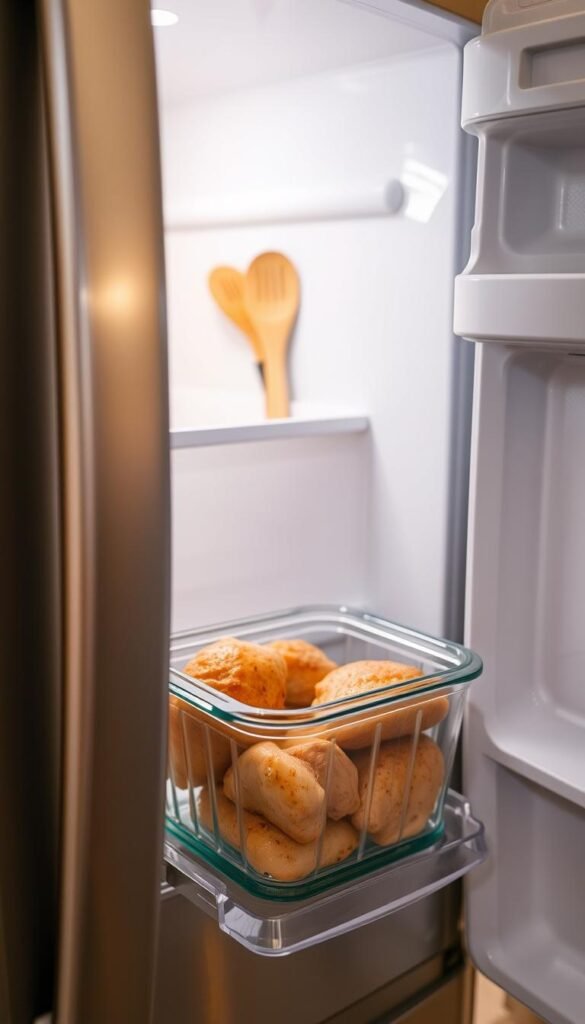
Fridge and freezer
Short-term: Store in airtight containers up to 4 days in the refrigerator.
Long-term: Freeze up to 3 months. Many cooks remove meat from bones before freezing to save space and to reheat more evenly.
Best ways to reheat
To preserve crisp skin, reheat in a 350°F oven for about 15 minutes or use an air fryer at 350°F for 3–4 minutes. The microwave is fastest but will soften the exterior.
Reheat in a baking dish or on a pan lined with foil for easy cleanup. Avoid covering if you want the surface to re-crisp.
- Warm saucy elements separately and spoon them on at the end so skin stays crisp.
- Save a spoonful of rendered fat to jump-start a quick pan sauce the next day.
- Assemble sheet-pan meals ahead; bring to room temp 30–60 minutes before roasting so the thighs and vegetables cook evenly.
- Portion into single-serving containers and label with reheating instructions and date.
“A short reheat in the oven or air fryer is the best way to keep texture and flavor.”
| Storage | Duration | Reheat method | Notes |
|---|---|---|---|
| Refrigerator (airtight) | Up to 4 days | 350°F oven, ~15 minutes | Best for keeping skin crisp; use a baking dish |
| Freezer (portion) | Up to 3 months | Thaw overnight, then oven or air fryer | Remove from bones to save space and heat evenly |
| Air fryer | Quick reheat | 350°F, 3–4 minutes | Fastest way to re-crisp without drying |
| Microwave | Immediate | 30–60 seconds | Fast but softens skin; best for sauced pieces |
Nutrition and calories at a glance
Knowing typical calorie ranges for common preparations keeps meal planning realistic and simple.
Quick benchmarks: A saucy skillet preparation averages about 360 kcal per serving with roughly 19 g protein and 30 g fat. A hearty sheet-pan version with root vegetables can reach about 575 kcal per serving. Classic oven-baked pieces land near 536 kcal with about 38 g protein and 41 g fat.
- Calorie drivers: rendered skin, butter or cream, oil, and starchy sides.
- Measure to control portions: use 1/2 cup broth in sauces and teaspoon measures for spice blends.
- Simple swaps—half-and-half or lighter pan sauces—cut fat and calories while keeping flavor.
- For accurate tracking, weigh cooked portions and log sauce separately.
“Balance plates with greens or a salad to keep meals satisfying without excess calories.”
Note: Nutrition values are estimates. They change with portion size, how much skin you eat, and cup-for-cup swaps in sides. Use these numbers as a guide when choosing a chicken thighs recipe that fits your goals.
Conclusion
Match your schedule to a cooking style—skillet sear, sheet-pan roast, or a steady oven bake—and dinner is solved. Pick a hot skillet, a loaded pan, or the oven and follow the timing that fits your night. Sear for a quick sauce, roast for hands-off flavor, or bake for steady browning.
Use a simple, balanced rub and manage heat so the thighs and skin crisp while the meat stays juicy. Finish with fresh herbs, lemon, and a light sauce to lift each plate. Choose the chicken thighs recipe that matches your time and tools, then tweak spices to make it yours.
Store leftovers smartly and reheat in the oven or air fryer to keep texture. You now have the core playbook to turn pantry staples into a top dinner or lunch. Cook with confidence and enjoy these versatile, budget-friendly recipes.
